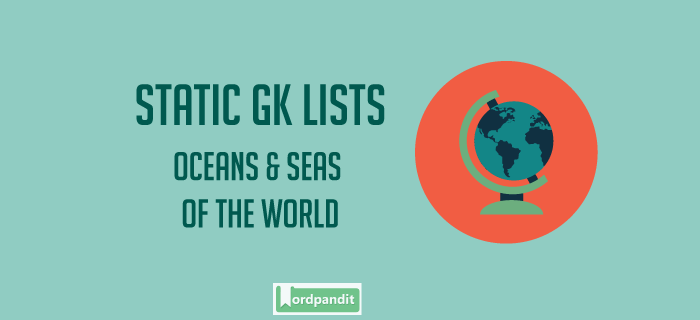Oceans & Seas of the World
The Oceans
The oceans are the some of the most mysterious places on the planet. Although there is much we have not yet discovered,
Water covers more than 70 percent of the Earth’s surface, with the largest body of water, the Pacific Ocean, taking up more than one-third of the planet’s surface. Here are the top biggest seas and oceans in the world, as measured by surface area in square miles (square kilometers).
| S. NO | Name | Area | Average depth | Greatest known depth | Place of greatest known depth | |||
| sq. mi. | sq. km | ft. | m | ft. | m | |||
| 1 | Pacific Ocean | 63,800,0000 | 15,55,57,000 | 13,215 | 4,028 | 35,827 | 10,920 | Mariana Trench |
| 2 | Atlantic Ocean | 41,100,000 | 106,460,000 | 12,880 | 3,926 | 30,246 | 9,219 | Puerto Rico Trench |
| 3 | Indian Ocean | 27,240,000 | 70,560,000 | 13,002 | 3,963 | 24,460 | 7,455 | Java Trench Sunda Trench |
| 4 | Southern Ocean | 78,48,300 | 2,03,27,000 | 13,100–16,400 | 4,000–5,000 | 23,736 | 7,235 | South Sandwich Trench |
| 5 | Arctic Ocean | 54,27,000 | 1,40,56,000 | 3,953 | 1,205 | 18,456 | 5,625 | Arctic Basin 77°45’N; 175°W |
Some Facts about ocean
- The Southern Ocean (Sometimes called the Antarctic Ocean) was approved in 2000 by the International Hydrographic Organization It is now the fourth largest ocean. Official depths for the Southern Ocean are still not available at this time.
- Some scientists have said that the Arctic Ocean could be ice-free in the summer in as little as 30 years.
- The Indian Ocean’s calm surface allows for its trade routes to open up earlier in the year than the Atlantic and Pacific Oceans, with many Indian Ocean states exporting raw materials such as silk, rice and sugar, according to the Indian Ocean Rim Association for Regional Cooperation (IOR-ARC).
- Despite its relative calm, the Indian Ocean was the site of one of the most devastating tsunamis in history. An underwater earthquake on December 26, 2004 created goliath waves that hit the countries surrounding the Indian Ocean, resulting in the deaths of more than 226,000 people and leaving more than one million people homeless
- the Pacific basin is where about 81 percent of the world’s largest earthquakes occur, according to the United States Geological Survey (USGS).
Major Seas
Seas are smaller than oceans. They usually most often be found in areas where oceans and land meet.
- The Caspian Sea is called “sea” because the Romans, finding it salty, named it Mare Caspium. Many geographers, however, consider it a lake because it is land-locked.
- Varies with the rainfall of the wet season It has been reported to dry up almost completely on occasion
- A recent study has also found that the Mediterranean is feeling the effects of global warming, having become both warmer and saltier in recent decades.
Major Seas
Seas are smaller than oceans. They usually most often be found in areas where oceans and land meet.
- The Caspian Sea is called “sea” because the Romans, finding it salty, named it Mare Caspium. Many geographers, however, consider it a lake because it is land-locked.
- Varies with the rainfall of the wet season It has been reported to dry up almost completely on occasion
- A recent study has also found that the Mediterranean is feeling the effects of global warming, having become both warmer and saltier in recent decades.
| S. NO | Name | Area | Average depth | Greatest known depth | Place of greatest known depth | |||
| sq. mi. | sq. km | ft. | m | ft. | m | |||
| 1 | Mediterranean Sea | 11,44,800 | 29,65,800 | 4,688 | 1,429 | 15,197 | 4,632 | Off Cape Matapan, Greece |
| 2 | Caribbean Sea | 10,49,500 | 27,18,200 | 8,685 | 2,647 | 22,788 | 6,946 | Off Cayman Islands |
| 3 | South China Sea | 8,95,400 | 23,19,000 | 5,419 | 1,652 | 16,456 | 5,016 | West of Luzon |
| 4 | Bering Sea | 8,84,900 | 22,91,900 | 5,075 | 1,547 | 15,659 | 4,773 | Off Buldir Island |
| 5 | Gulf of Mexico | 6,15,000 | 15,92,800 | 4,874 | 1,486 | 12,425 | 3,787 | Sigsbee Deep |
| 6 | Okhotsk Sea | 6,13,800 | 15,89,700 | 2,749 | 838 | 12,001 | 3,658 | 146°10’E; 46°50’N |
| 7 | East China Sea | 4,82,300 | 12,49,200 | 617 | 188 | 9,126 | 2,782 | 25°16’N; 125°E |
| 8 | Hudson Bay | 4,75,800 | 12,32,300 | 420 | 128 | 600 | 183 | Near entrance |
| 9 | Japan Sea (East Sea) | 3,89,100 | 10,07,800 | 4,429 | 1,350 | 12,276 | 3,742 | Central Basin |
| 10 | Andaman Sea | 3,08,000 | 7,97,700 | 2,854 | 870 | 12,392 | 3,777 | Off Car Nicobar Island |
| 11 | North Sea | 2,22,100 | 5,75,200 | 308 | 94 | 2,165 | 660 | Skagerrak |
| 12 | Red Sea | 1,69,100 | 4,38,000 | 1,611 | 491 | 7,254 | 2,211 | Off Port Sudan |
| 13 | Baltic Sea | 1,63,000 | 4,22,200 | 180 | 55 | 1,380 | 421 | Off Gotland |
| 14 | Arabian Sea | 1,491,000 | 3,862,000 | 15,262 | 4,652 | |||
| 15 | Black | 168,500 | 436,402 | |||||













